

Department Name: Writing Center
College Name: Library & Learning Services
Department Head: Rob Gray
Department Mission Statement (required for NWCCU):
The mission of the Dixie State University Writing Center is to assist students in developing, drafting, and revising their writing through peer-to-peer consultation and small group instruction. We strive to create an academic community of strong and confident writers, both at Dixie State University and in the southern Utah community.
Strategy: Develop multiple advertising strategies to reach both faculty and students in order to increase the number of consultations the Writing Center completes each year.
Strategy: Work with department chairs to develop further the Writing Center’s departmental tutoring program.
Strategy: Improve the quality of tutoring in the Writing Center by instituting a continuing education program for the Writing Center’s tutors and implementing CRLA certification into the Writing Center’s tutor training courses.
Strategy: Assess the Writing Center’s current traffic and capacity by reviewing week-by-week, day-by-day, and hour-by-hour consultation data to accommodate students’ tutoring needs as efficiently as possible, with tutoring hours corresponding directly with demand.
Director of Learning Services:
Rob Gray attended the Utah CRLA convention and the national CRLA convention. He also attended tutor center management training at Engineerica’s corporate office. He was a co-writer on a large Atwood Retention Grant, and helped create the University’s supplemental instruction program. He served on several task forces and committees including the University’s Trailblazer Connection committee. He suggested and implemented study hall tutoring for athletes. He also implemented a Library and Learning Services internship to publish a monthly, student-written newsletter. He received grants to develop three online tutor and mentor training courses and recently received a grant to develop an English course using OER.
Student Coordinators:
Braxton Thornley was our Writing Center coordinator through the end of fall semester. He was the University’s Valedictorian for 2018-2019. He accepted an offer to teach English at Bingham High School. He also wrote articles for the DSU Annual Academic Report.
Brittany Bennett became our coordinator in spring 2019. She was the History Department student of the year and wrote articles for the DSU Annual Academic Report.
Student Tutors:
April VeVea was nominated for the History Department student of the year. She graduated this spring and was accepted to the English MA program at DSU. She was also interviewed about her Old Hollywood work by the school paper and St. George News, and she guest-starred for a TCM program to talk about Mae West. She participated in the first Phi Alpha Theta Utah Regional Conference held at DSU this year.
Emma Lee began the academic year as a tutor in the Writing Center and was soon promoted to coordinator in the Academic Performance Center. She graduated from DSU this spring and has accepted an offer to attend USU Master of Technical Writing program in the fall.
Ryann Heinlen worked as an editor for the Dixie Sun News and attended a journalism conference in California during spring semester. She recently graduated and accepted a position as a writer for the Southern Utah News. She will also work as a supplemental instruction leader in Rob Gray’s English 1010 course next fall.
Cambron Sherman worked as a writing tutor to begin the academic year and was promoted to Academic Performance Center coordinator before accepting a management position at Techie for Life in the fall.
Abby Doman worked for the Dixie Sun News as a reporter and attended a journalism conference in California this spring. She will be the managing editor of the Dixie Sun newspaper next academic year.
Ryan Gibb is the only pre-medical student at DSU attending a competitive biomedical internship at Stanford this summer.
Kaitlynn Ehlers is entering the English Education student teaching program this fall.
Madalyn Schiller graduated at the end of fall semester, and she accepted a research assistant position at Drake University in Iowa.
| Name and Degree | Tenure Status T = Tenured TT = Tenure Track NTT = Non Tenure Track |
Rank | Faculty FTE | Released Time in Credit Hours |
|---|---|---|---|---|
| Rob Gray, MFA | NTT | Interim Director | 1.0 | N/A |
Number of part-time student tutors and coordinators: 15
A. During the fall 2018 semester, the Writing Center completed 1,720 consultations, a 17 percent increase in total consultations over the spring 2018 semester (graph provided below).

B. The Writing Center was able to add one more department-specific tutor for nursing. The Nursing Department has requested a specialty tutor for several semester, but until now, we have not been able to find a qualified candidate.
C. Between the 2017–2018 academic year and the 2018-2019 year, the number of specialized tutoring sessions that the Writing Center completed with APA students, primarily psychology, increased by 18 percent, from 337 specialized sessions to 399.
D. Between the 2017–2018 academic year and the 2018–2019 year, the number of synchronous online tutoring sessions that the Writing Center completed increased by 92 percent, from 179 online tutoring sessions to 344.
A. The Writing Center has conducted a control-group study and analysis to assess the impact of tutoring sessions in English 1010 and 1010D courses on in-class performance, overall academic achievement, and retention. The Executive Summary overview and results are listed below:
Overview
This report analyzes the records of 135 new freshman who took English 1010 or 1010D and went to the Writing Center to receive assistance with their papers in fall 2016. It includes another 669 students taking English 1010 or 1010D in the same semester who did not receive assistance. The outcomes (measured in terms of GPA in the English course, GPA during the fall term, and retention as of fall 2017) are presented below. Although no analysis accounts for all factors, results provide support that the Writing Center has a positive impact on these outcomes. This information should be shared with students to encourage their participation.
Results
• The fall-to-fall retention rate for new freshman obtaining assistance from the Writing Center was 60% compared to 48% for new freshman not obtaining help from the Writing Center (Chi-Square 5.507, significant p < .01). • The average GPA in English 1010 or 1010D for new freshman obtaining assistance from the Writing Center was 3.03 compared to 2.51 for students not obtaining assistance (t-test -4.27, significant p < .01). • The average fall term GPA for new freshman obtaining assistance from the Writing Center was 3.09 compared to 2.47 for new freshman not obtaining assistance from the Writing Center (t-test -6.792 significant p < .01).
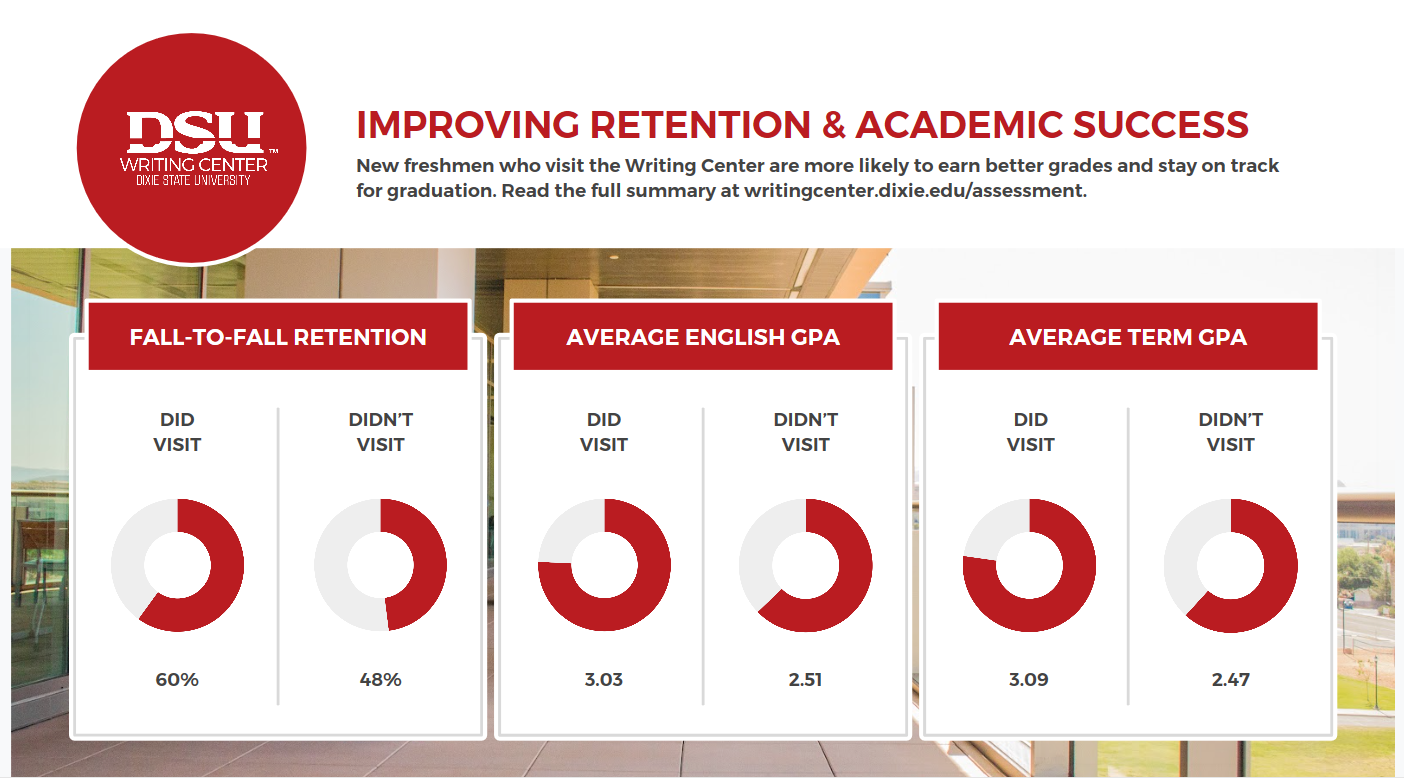
B. During the 2018-2019 academic year, the Writing Center completed 3,194 consultations, a 13 percent increase in total consultations over the previous academic year.
C. In an online survey administered to faculty on their perceptions of the Writing Center, we found that most faculty believe that the Writing Center is effective in helping their students become stronger writers. However, from this same survey, the Writing Center also found that many faculty members have misconceptions about the Writing Center’s services; although, we added a “faculty resources” page to our website last year. To provide a more effective message, we plan to have an open house for faculty and staff during the first week of the fall 2019 semester.
D. In online, in-class surveys administered to English 1010 or 1010D students before and after mandatory tutoring visits, 79% of those who had not visited the Writing Center before said they were unaware of Writing Center services. When asked pre-visit if students would recommend Writing Center services to a friend, only 38% said they would. After visiting, 76% would recommend services to a friend. In addition, when asked pre-visit if students would visit the Writing Center for help with future courses, only 29% said they would. Post visit, 75% said they were likely to visit for future classes. Finally, when asked pre-visit how much students thought the Writing Center could help them on their essays, only 34% said the help would be substantial. However, post visit, 73% said they received substantial essay help.
Pre-Visit Responses (next page):
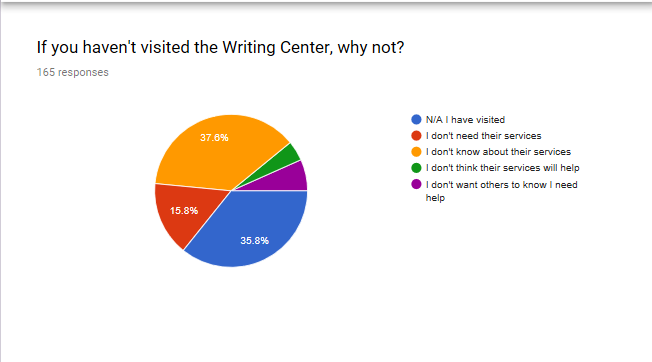
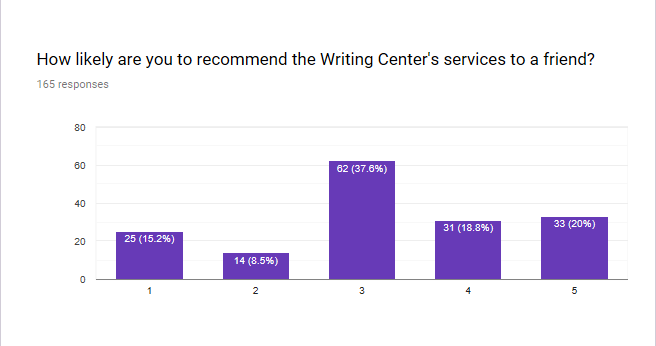
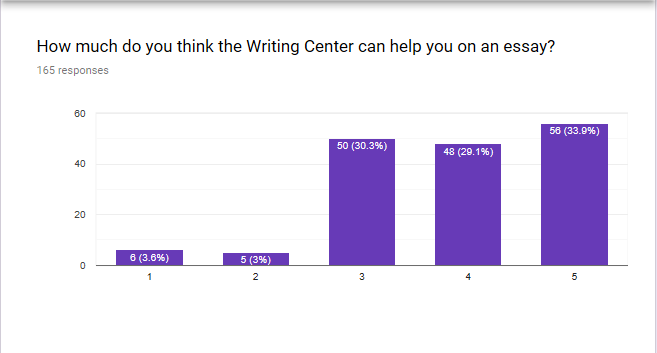
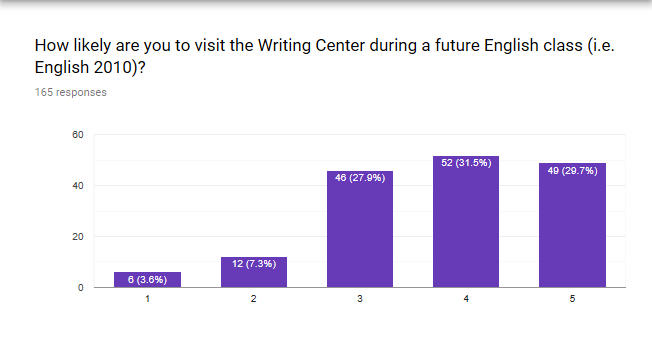
Post-visit Responses (next page):
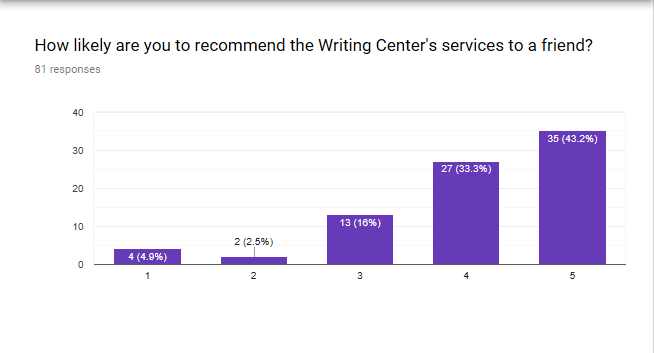
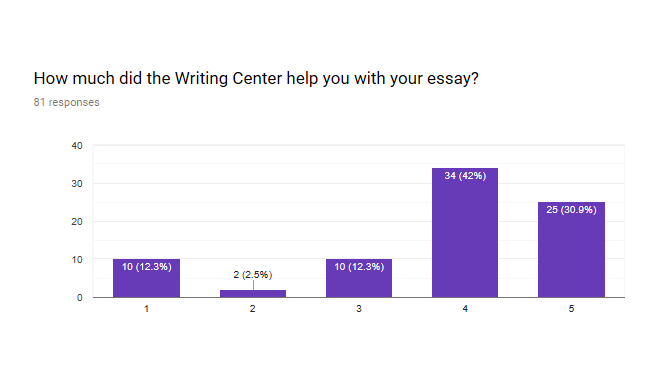

Strategy: Increase total consultations next academic year
Strategy: Increase Departmental Tutoring
Strategy: Show Writing Center Effectiveness
Strategy: Increase Department Efficiency
The Writing Center’s biggest need in the next few years will be additional space. As our program continues to grow and as the Athletic Department will require additional tutoring to meet Division 1 standards, Learning Services will need additional room. Our suggestion is to combine the Honor’s Lab with the English Department Collaborative Learning Space, as both are underused, and create one large tutoring space between the Academic Performance Center, the Writing Center and the Honor’s lab space.
Another need will be additional funding, and we plan to address this with a Title III grant.